Masterpiece Story: The Pineapple Picture
Known as the “pineapple picture,” this enigmatic 17th-century painting captures the royal reception of King Charles II. The British royal...
Maya M. Tola 10 June 2024
The Scottish Colourists were a group of Post-Impressionist Scottish painters active in the first half of the 20th century. Their way of painting turned them into avant-garde artists in the Scottish artistic panorama, surpassing the pictorial revolutions made earlier by the Glasgow Boys. Influenced by French Impressionists and Fauvists, the Scottish Colourists were radical in their use of color and a free, almost wild application of brushstrokes. Let’s travel together to Scotland (unless you’re already there) and meet the Scottish Colourists!
The Scottish Colourists were integrated by four artists: Francis Campbell Boileau Cadell, George Leslie Hunter, John Duncan Fergusson, and Samuel John Peploe, probably the best-known member of the group. They didn’t have a common purpose or goal, in fact, they never constituted a formal group. Furthermore, the didn’t receive the name that encompasses them until the middle of the 20th century when critics began to recognize them.
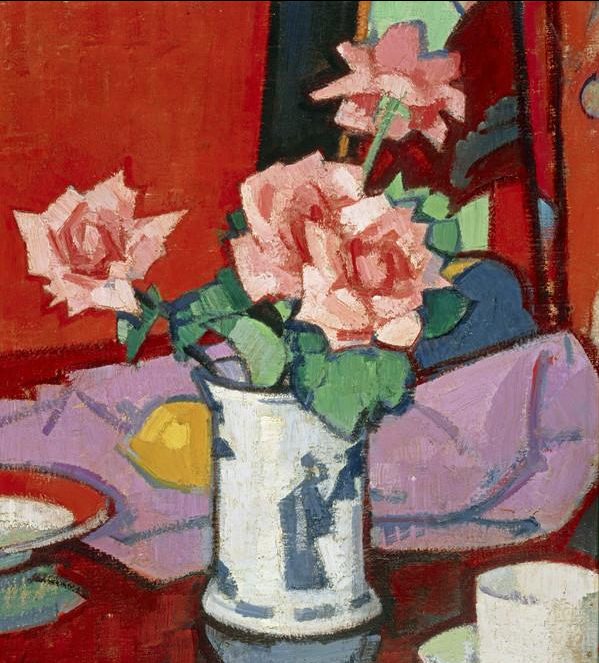
Samuel John Peploe, Pink Roses, Chinese Vase, 1916-1920, National Galleries of Scotland, Edinburgh, UK.
Samuel John Peploe (1871-1935) was born in the heart of a well-to-do family from Edinburgh. In 1894, Peploe began his formal art training at the Trustees Academy in the capital of Scotland. However, the traditional and conservative lines of the Academy did not satisfy him. Some years later he moved to Paris, where he lived between 1910 and 1912, and studied at Académie Julian in Paris. There the Scottish painter was deeply influenced by French artists, such as Paul Cézanne, and the new trends in French painting – such as Japonisme.
Peploe was especially intrigued by the properties of color and the visual problems of painting. Looking at artworks such as Landscape at Cassis, one might feel a reminiscence of Cézanne in the structure of the composition and the use of rich and bold colors in a similar way to the Fauvists.
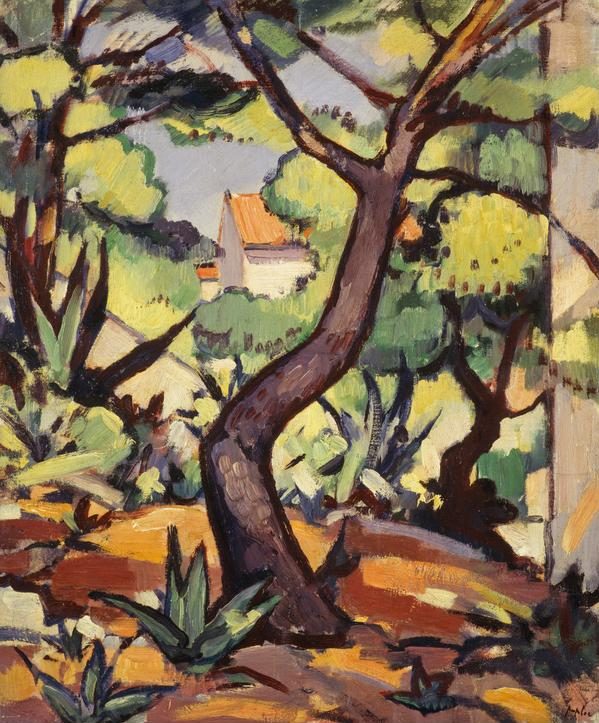
Scottish Colourists: Samuel John Peploe, Landscape at Cassis, 1924, National Galleries of Scotland, Edinburgh, UK.
Peploe was also invested in the still life genre. As an author, Stanley Cruister defined Peploe’s works: “In still-life groups and flower pieces he struggled with simple masses of pure color…; every change of plane was to be represented by a change of color; the whole paraphernalia of tone had been thrown overboard”.1 As the artist himself recognized, this particular subject fascinated him the most: “There is so much in mere objects…flowers, leaves, jugs, what not–colors, form, relation–I can never see the mystery coming to an end”.2 Peploe delighted himself in the shocking juxtaposition of tonalities and a very gestural and explosive way of applying the brushstroke.
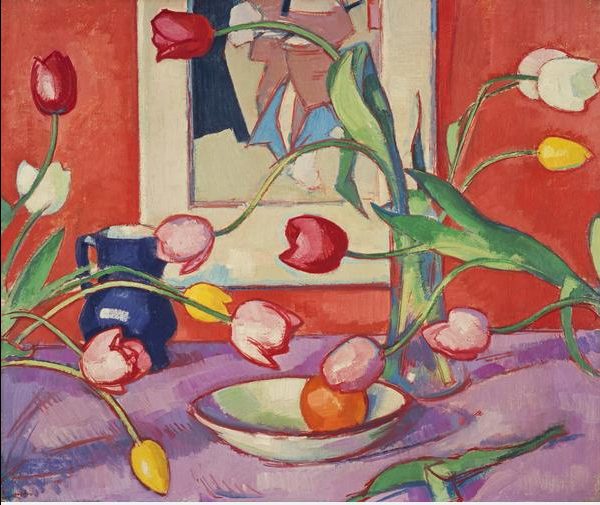
Scottish Colourists: Samuel John Peploe, Tulips – The Blue Jug, 1919, National Galleries of Scotland, Edinburgh, UK.
Francis Campbell Boileau Cadell (1883-1937) followed a similar trajectory to that of Samuel Peploe with whom he maintained a close relationship, both personally and artistically. As well as Peploe, Cadell joined the Trustees Academy whose guidelines were soon abandoned in favor of new artistic trends in European painting. A trip to Venice in 1910 was a turning point in his career. Probably inspired by the bright Mediterranean light, he opted for creating luminous surfaces and soft color schemes, close to the Impressionist’s techniques.
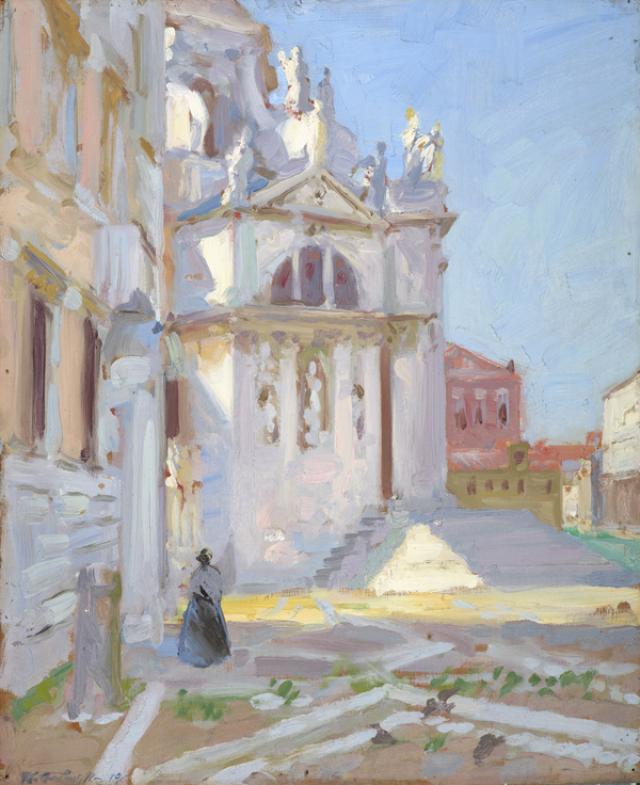
Scottish Colourists: FCB Cadell, Santa Maria della Salute, Venice, 1910, National Galleries of Scotland, Edinburgh, UK.
After the war Cadell’s technique changed, leaving Impressionism behind and shifting towards new avant-garde trends such as Fauvism. Still lifes and interiors, some of his most recurrent themes, were composed of flat masses of strong colors, eliminating depth and shadows.
Of the Scottish Colourists, it was perhaps George Leslie Hunter (1877-1931) who had the most diverse upbringing within the group. In 1892, Hunter’s family emigrated to California where the painter began to train as a draftsman and illustrator. In 1906, Hunter returned to Scotland after a terrible earthquake in San Francisco. While settling in Scotland, he undertook a series of trips throughout Europe, where he imbibed the avant-garde style. Especially important was his stay in the artistic colony of Les Étaples in France where he acquired the style that would lead him to be considered a colorist. While looking at his magnificent still life compositions such as Chrysanthemums in a Chinese Vase one can see a reference to masters such as Cézanne. In Still Life with Flowers and Fruit the Fauvist influence of Matisse is visible.
Like other members of the Scottish Colourists, George Leslie Hunter was also noted for his landscapes. His vistas of the Scottish region of Fife convey a certain atmosphere through his palette and the use of colors.
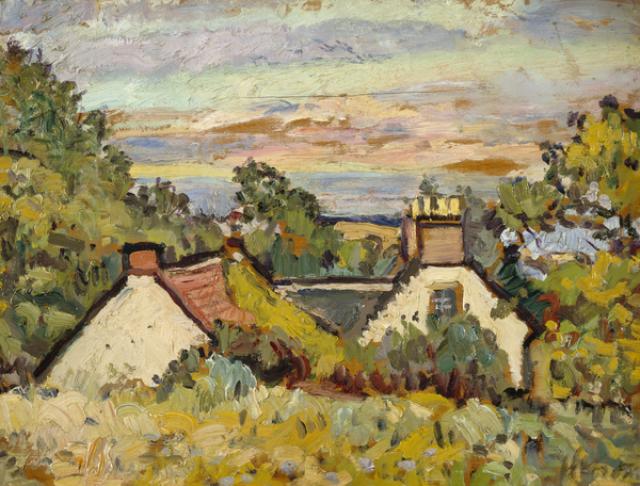
Scottish Colourists: George Leslie Hunter, Cottages, Fife, 1923-1924, National Galleries of Scotland, Edinburgh, UK.
Similar to other artists such as Claude Monet, Hunter was deeply intrigued by the effects of light on different surfaces such as water. Proof of this is the work Reflections, Balloch, where Hunter studies the effects of the reflections of light on lake Loch Lomond, northwest of Glasgow.
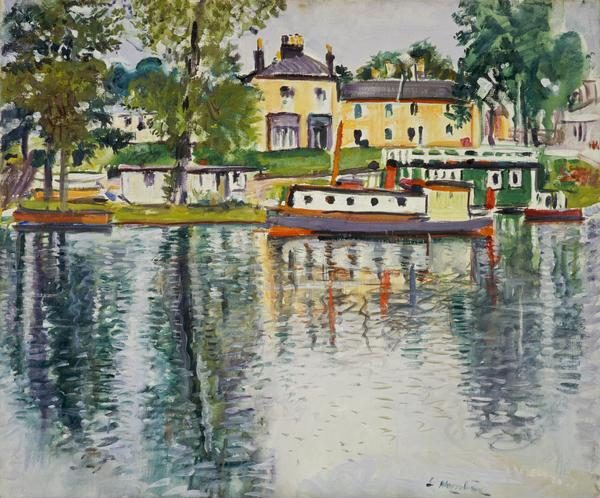
Scottish Colourists: George Leslie Hunter, Reflections, Balloch, 1929-1930, National Galleries of Scotland, Edinburgh, UK.
Of the four members of the Scottish Colourists, John Duncan Fergusson (1874-1961) was the group’s self-taught painter. Early in his career, his style was strongly influenced by James McNeill Whistler and the Glasgow Boys. Later, after a trip to Paris in 1907, moving through the bohemian circles of Paris where he met Matisse and Picasso, his works acquired a more avant-garde style. Of the group members, he had perhaps the strongest tendency towards Fauvism.
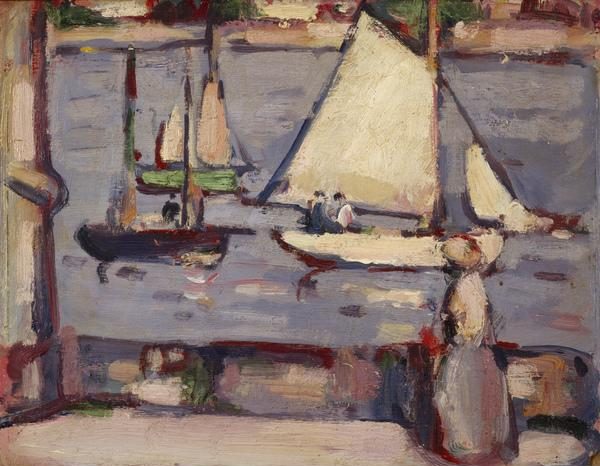
Scottish Colourists: John Duncan Fergusson, Twilight, Royan, 1910, National Galleries of Scotland, Edinburgh, UK.
In the work Twilight, Royan, we see a style very close to that of the Fauvist painter André Derain. The work acquires a geometric composition, especially in the sails of the ships, and is formed by intense brushstrokes and pure colors.
Like Arles for Van Gogh, Giverny for Monet, or the Mediterranean for Sorolla, the preferred place of inspiration for the Scottish Colourists was the Western Scottish islands, especially Iona. So, it is essential to mention this natural paradise as a source of inspiration for our artists. On Iona, the Scottish Colourists could experiment with the pure and strong colors of the sea, the changing atmosphere, the strong contrast between the white sand and the intense blue of the water, as well as the ripples of light on its surface.
It was thanks to works such as these that the Scottish Colourists changed the Scottish pictorial landscape. We hope after this article you now know a little more about the Scottish Colourists and love them as much as we do!
Two Scottish Colourists: Samuel John Peploe, R.S.A. and Francis Campbell Boileau Cadell, R.S.W., London: The Lefevre Gallery, 1988.
The Scottish Colourists: 1900-1930: Royal Academy of Arts, London: Dean Gallery, Edinburgh, The Trustees of the National Galleries of Scotland, 2000.
The Scottish Colourists…
DailyArt Magazine needs your support. Every contribution, however big or small, is very valuable for our future. Thanks to it, we will be able to sustain and grow the Magazine. Thank you for your help!